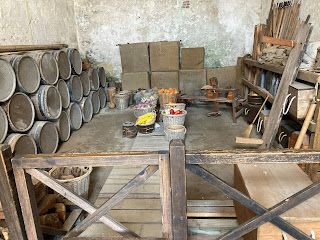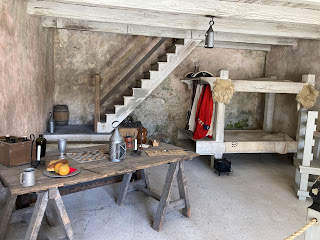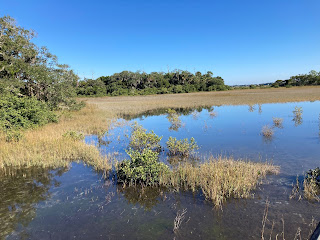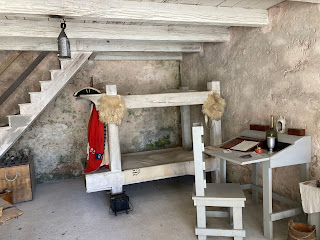I alluded in a previous post about how different the Castillo felt, nearly empty of visitors. Perhaps that contributed to my lack of feeling any emotion at the visit. Had an email exchange with a friend who is one of the park rangers stationed there: "Saw [mutual friend X] at the Castillo when we visited last week ... it was weirdly empty and quiet without school kids or soldados, etc. Hope everyone stays safe and we're back to normal (or "new normal" whatever that looks like) soon."
"It has indeed been strange, for those of us who remember the Before Times!" my friend replied. "What's also interesting is, we have a number of new employees who have come on board since March 2020 who have no idea what "normal" looks like for this place." So, a brief photo tour, of the Fort you can no longer see, and what it looks like now.
 |
| In the "Before Times" costumed reenactors helped visitors understand what things might have been like. |
 |
| Special night events, candlelight tours, added the aura of mystery. We've attended and participated in many of these events, often portraying shipwrecked sailors. Next morning, energized by my interactions with people, I posted that my garb smelled of woodsmoke, black powder, and adventures. |
 |
| Preparing to visit last week ... what a difference! |
 |
| The weirdly empty courtyard. During the sieges the entire 1,500 townspeople stayed here for 1-2 months. Today, not a visitor in sight. |
 |
| The casemates were originally used as storerooms for food, tools, gunpowder. |
 |
| Then later during the British period the walls were expanded and these rooms were used as living quarters. |
After this visit, and the administrative work which had been the primary motivation for our trip complete, we spent an hour or so the last morning at the site of Fort Mose, 2 miles north of the Castillo. I delight in the rarely-told story of this place; the first free Black settlement in the US; the place where escaping enslaved people folloowed the Underground Railroad south instead of north from Georgia and South Carolina, to the then-international border between England's and Spain's colonies. In the US, we tend to think of ourselves as derived from the British – Boston Tea Party, 13 original colonies, 1776 and all that. We forget that New York was Dutch, Michigan and Louisiana were French, and Florida was Spanish. Unlike the Castillo, this fort is gone and its struggles remembered only in stories, the landscape given back to the birds and marshes.
 |
| The long boardwalk to the site, dubbed "Walkway to Freedom." |
 |
| It looks so peaceful, but it's anything but quiet, filled with the squawks, chirps, and quacks of the birds making their living fishing in the marsh. |
















No comments:
Post a Comment